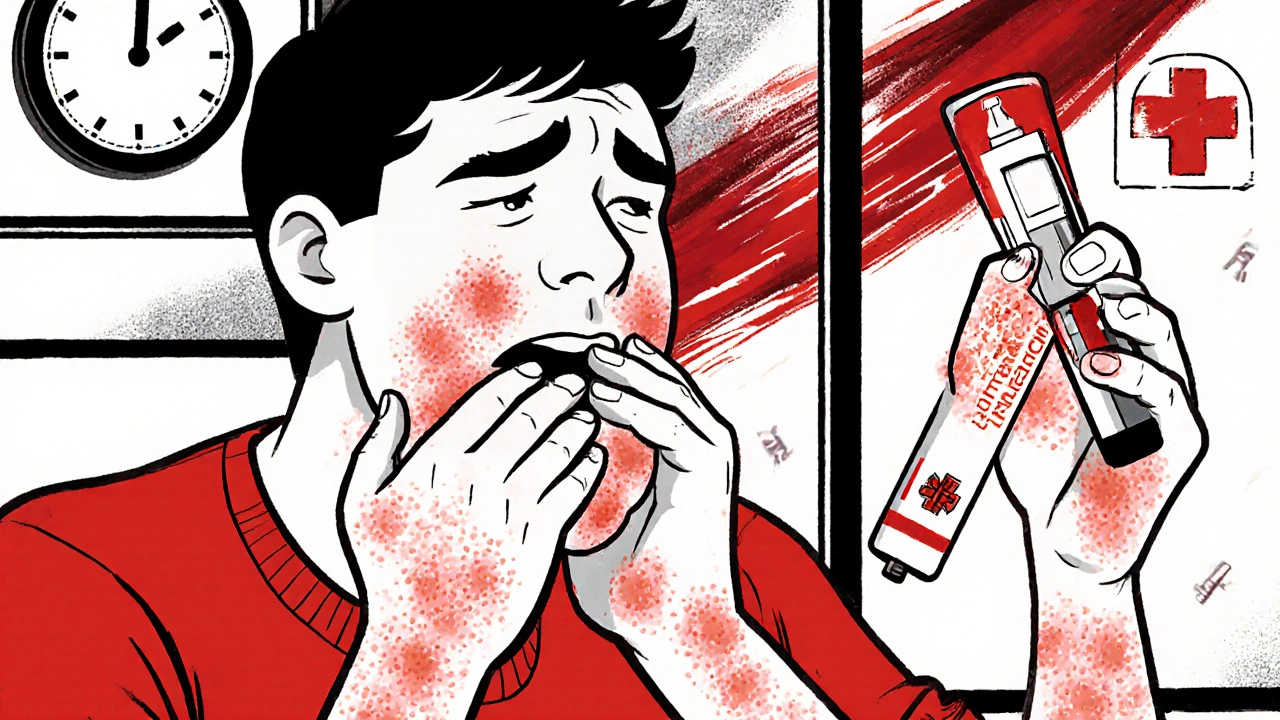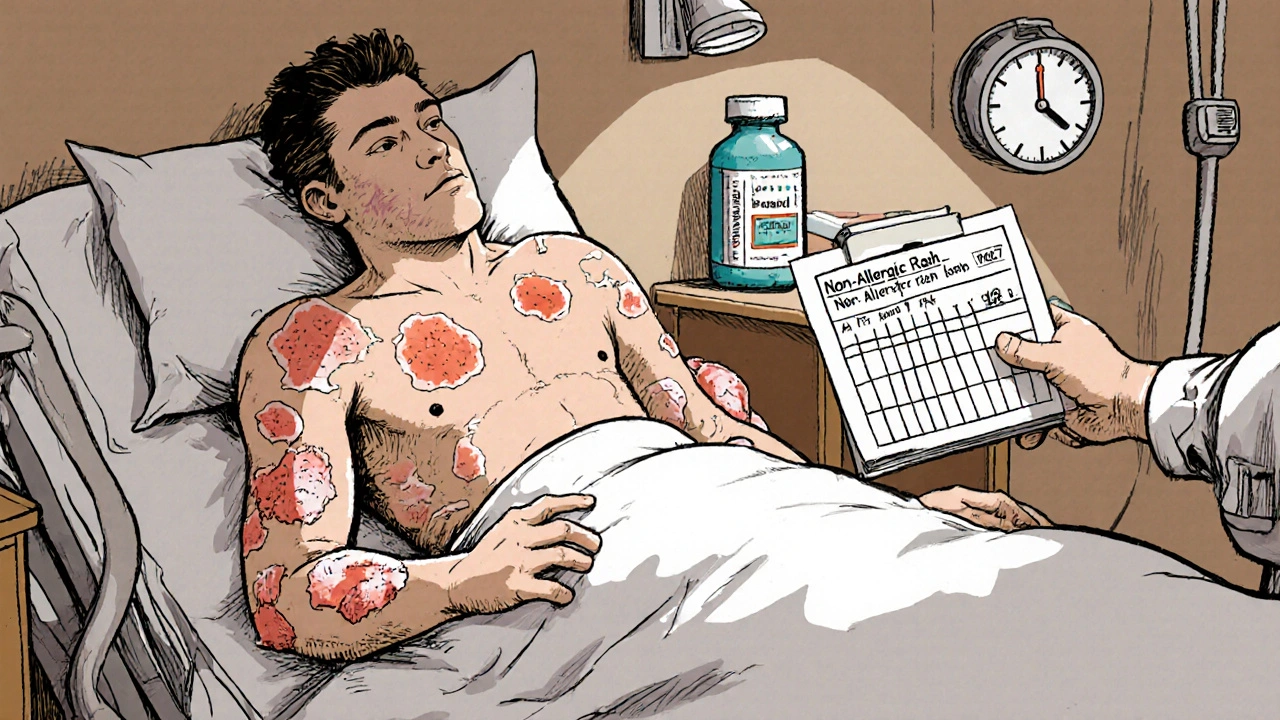Most parents and even some adults panic when a rash shows up after starting an antibiotic. It’s common. It’s scary. And most of the time, it’s not a true allergy. But how do you know the difference? Stopping the antibiotic when you don’t need to can make the infection worse. Keeping it going when you should stop can be dangerous. This isn’t about guessing. It’s about recognizing clear signs - and knowing exactly when to act.
Most Antibiotic Rashes Aren’t Allergies
If you or your child gets a rash on day 5 or 6 of taking amoxicillin or another penicillin-based antibiotic, chances are it’s not an allergy. In fact, up to 90% of kids labeled as allergic to amoxicillin because of a rash turn out to be fine when tested properly. These rashes are called non-allergic drug eruptions. They’re common - happening in 5 to 10% of children on amoxicillin - but they’re not dangerous in themselves. These rashes usually look like small, flat, pink or red spots that spread across the chest, stomach, or back. They don’t itch much, if at all. They don’t move around. They don’t turn into big, swollen welts. And they show up late - typically between days 5 and 10 of treatment. That timing matters. True allergic reactions happen fast - within an hour of taking the pill. The rash isn’t your body rejecting the drug. It’s often linked to a virus you already have. Epstein-Barr virus (mono), colds, or other common infections can trigger this reaction when paired with amoxicillin. It’s not the antibiotic causing the problem - it’s the combo.What a True Allergic Reaction Looks Like
A real allergic reaction to antibiotics is different. It’s urgent. It’s noticeable. And it doesn’t wait. If you develop raised, red, itchy welts - like hives - within minutes to an hour after taking the antibiotic, that’s a red flag. These welts come and go. One moment they’re on your arm, the next they’re on your leg. They burn or sting. They might be accompanied by swelling around the lips, eyes, or throat. You could feel tightness in your chest, have trouble breathing, or feel dizzy. These are signs of anaphylaxis - a life-threatening reaction. You don’t wait. You stop the antibiotic immediately. You call 911 or go to the ER. If you have an epinephrine auto-injector (like an EpiPen), use it right away. Antihistamines like Benadryl help with mild itching, but they won’t stop anaphylaxis. Only epinephrine can.When a Rash Means Something Much Worse
Rare, but deadly, are severe cutaneous adverse reactions (SCARs) like Stevens-Johnson Syndrome (SJS) or toxic epidermal necrolysis (TEN). These are medical emergencies. They happen in about 1 to 6 cases per million antibiotic prescriptions - so they’re extremely rare. But if you see them, you need to act fast. These rashes start like a regular one but quickly turn into painful blisters. The skin begins to peel off in sheets, like a bad burn. You get a high fever - over 101.3°F. Your eyes, mouth, or genitals swell or develop sores. Your skin feels tender, like it’s sunburned. This isn’t a rash you treat at home. This needs hospitalization - often in a burn unit. Another rare but serious reaction is DRESS syndrome. It shows up later - around 2 to 6 weeks after starting the drug. You get a widespread rash, fever, swollen lymph nodes, and organ inflammation (like liver or kidney damage). If you have any of these symptoms, stop the antibiotic and get help immediately.
When to Keep Taking the Antibiotic
If your rash is flat, non-itchy, appears after day 5, and you feel fine otherwise - no fever, no swelling, no trouble breathing - then you should keep taking the antibiotic. This is what most pediatricians and allergists now recommend. Stopping antibiotics unnecessarily does more harm than good. A 2023 study found that when parents stop amoxicillin because of a rash, their child is 37% more likely to have a treatment failure - meaning the infection comes back worse. That often means switching to a stronger, broader-spectrum antibiotic like clindamycin or azithromycin. Those drugs are more likely to cause severe diarrhea or even C. difficile infections - which can be life-threatening. The CDC and the American Academy of Allergy, Asthma & Immunology both say: if the rash is non-urticarial (not hives), non-pruritic (not itchy), and without systemic symptoms, continue the antibiotic. You can manage mild itching with over-the-counter cetirizine (Zyrtec) or famotidine (Pepcid), and apply hydrocortisone cream to the worst spots. The rash will fade on its own in 5 to 7 days.What to Do Right Now
Don’t guess. Don’t rely on internet advice. Don’t stop the antibiotic just because you’re scared. Here’s what to do:- Take a photo. Save it. Show it to your doctor.
- Check the timing. Did it start before day 5? That’s more likely to be an allergy.
- Check the look. Are the spots raised and itchy? That’s hives. Flat and not itchy? Probably not an allergy.
- Check for other symptoms. Fever? Swelling? Trouble breathing? Go to the ER.
- Call your doctor. Send them the photo and describe what you see. Don’t wait for an appointment.

Why Mislabeling Antibiotic Allergies Costs Lives
Labeling someone as allergic to penicillin based on a rash they had as a kid can have long-term consequences. People with that label are 69% more likely to get a different, less effective antibiotic. Those alternatives are more expensive, harder on the gut, and increase the risk of drug-resistant infections. The CDC estimates that unnecessary penicillin allergy labels cost the U.S. healthcare system $1.2 billion a year. They also lead to a 30% higher chance of getting a C. difficile infection - a severe, sometimes fatal diarrhea caused by antibiotic overuse. Here’s the good news: 92% of people who think they’re allergic to penicillin test negative when properly evaluated. That means most of those labels are wrong. But they stick. Because no one ever followed up.What Your Doctor Should Do Next
If you’ve had a rash on an antibiotic, your doctor should ask: Was it hives? Did it happen right after the dose? Were you sick with a virus? Did you have a fever or swelling? If the answer is no, they shouldn’t write "penicillin allergy" in your chart. They should write: "Maculopapular rash on day 7 of amoxicillin - non-allergic." Many hospitals now use electronic alerts to flag patients with old allergy labels and prompt doctors to consider testing. A new rapid test called PENtest can confirm or rule out penicillin allergy in just 15 minutes. More clinics are starting to offer it. If you’ve been told you’re allergic to penicillin because of a childhood rash, ask your doctor about getting tested. It’s safe. It’s quick. And it could save you from unnecessary antibiotics down the road.Bottom Line: Don’t Panic. Assess. Act.
A rash on an antibiotic doesn’t mean you’re allergic. Most aren’t. But some are. And some are deadly.- Stop the drug and call 911 if you have hives, swelling, trouble breathing, or a high fever.
- Call your doctor if you have a flat, non-itchy rash after day 5 - don’t stop the antibiotic on your own.
- Don’t label yourself as allergic based on a rash unless it was confirmed by testing.


All Comments
Allison Turner November 26, 2025
Ugh, another post telling us not to panic. Like that helps when your kid looks like a tomato and you’ve been up all night. I stopped the amoxicillin. So what? Better safe than sorry. Doctors don’t even know what they’re talking about half the time.
Also, why is everyone so quick to blame the virus? Maybe it’s the drug. Maybe it’s both. Who cares? I’m not giving my kid another round just because some study says it’s ‘probably fine’.
Darrel Smith November 28, 2025
Let me tell you something, folks. This whole ‘it’s not an allergy’ nonsense is a dangerous myth pushed by Big Pharma and lazy pediatricians who don’t want to deal with the paperwork. My niece got hives on day three, they told her it was ‘just a rash,’ and three days later she was in the ICU with swelling in her throat. That’s not a coincidence. That’s negligence. And now she’s labeled ‘penicillin allergic’ for life because no one had the guts to test her properly. We’re gambling with kids’ lives here, and it’s not even a close game.
Stop normalizing this. Stop trusting ‘studies.’ Stop trusting doctors who haven’t seen a real allergic reaction in ten years. If it looks weird, if it feels wrong - STOP THE DRUG. Then call 911. Then sue the hospital. I’m not joking.